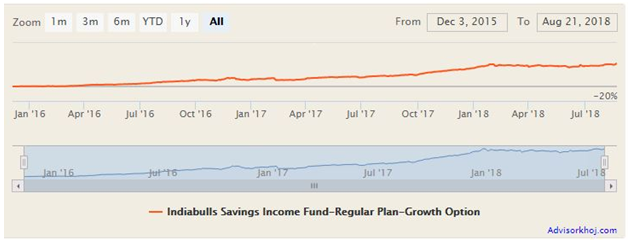Conservative Hybrid Mutual Funds: Good tax efficient options for moderately low risk appetites

Bank Fixed Deposits and Government Small Savings Schemes are automatic investment choices for vast majority of risk-averse investors in our country. While these schemes theoretically give risk free return, one has to look at risk through the prism of real returns and not nominal returns, which these schemes assure.
What is the difference between nominal returns and real returns? In very simple terms, it is inflation. Let us take prevailing Bank FD interest rates, which are now in the 6.7 – 7% range. FD interest is fully taxable as per the income tax rate of the investor. For investors in the highest tax bracket, the post-tax return is 4.7 – 4.9%. The average Consumer Price Index (CPI) inflation rate in 2018 is 4.6%. So the real return from Bank FD is just 0.1 – 0.3%. If inflation creeps up, a concern mentioned by the RBI Governor himself in the August monetary policy committee meeting, then FDs will give negative real returns. Investors should understand that, while FDs and Government Small Savings Schemes are nominally risk-free, in reality, they are subject to inflation risk.
Mutual funds, though subject to market risk, offer potentially higher returns beating inflation, giving real income to investors. The question is, how much risk should investors be willing to take and are their suitable mutual fund products, matching risk appetites for investors. Fortunately, mutual funds offer a vast range of products across the entire risk spectrum, by investing in different asset classes. Equity is highest risk asset class but gives the highest returns in long term, while debt is the lowest risk asset class but gives lower returns. A pure equity mutual fund is not suitable for investors who are looking for stable income and low volatility. A debt mutual fund, on the other hand, may not be able to meet income expectations of investors who were used to high interest rates in the past. In between equity and debt mutual funds, there is a category of funds known as hybrid mutual funds, which combine the risk / return characteristics of both debt and equity.
Different types of hybrid mutual funds for different risk capacities
Depending on their asset allocations, different types of hybrid mutual funds have different risk profiles, ranging from moderately aggressive to moderately conservative. Aggressive (equity oriented) hybrid mutual funds, also known as balanced mutual funds have 65% to 80% equity asset allocation and have moderately aggressive risk profiles. Dynamic Asset Allocation mutual Funds, also known as Balanced Advantage Mutual Funds and Equity Savings Funds are less volatile compared to Aggressive Hybrid Mutual Funds. These funds are suitable for moderate to moderately aggressive risk capacities. Conservative Hybrid Mutual Funds are least risky of all hybrid funds (excluding Arbitrage Funds).
A major part of the assets in Conservative Hybrid Mutual Funds are invested debt or money market securities – this provides considerable amount of downside protection to these investments.
Conservative Hybrid Funds
As per SEBI’s mandate, Conservative Hybrid Mutual Funds should have at least 75 to 90% investments in debt and money market securities. Asset allocation in equities should be in the range of 10 to 25%. Since 75 to 90% of the portfolio is in relatively low risk assets, these funds are much less volatile than equity and other hybrid funds. The debt portion of the portfolio generates stable income, while the equity portion gives a kicker to returns in form of capital appreciation over a sufficiently long investment tenor.
Debt strategy of Conservative Hybrid Funds
Since regular income is primary investment objective of conservative hybrid funds (many of these funds were previously named monthly income plans), fund managers of the debt portions of these funds usually employ accrual strategy. In accrual strategy, debt and money market securities are usually held till maturity of the securities and the interest paid by the securities are accrued. In accrual strategy interest rate changes do not impact returns over the residual maturity tenor of the securities.
Good conservative hybrid funds usually ensure high credit quality in the debt portfolio. As a result, the debt portion is able to generate stable, consistent returns for investors with limited downside risks. Some fund managers take credit calls to lock in higher yields by investing a portion of the assets in slightly lower rated corporate bonds (non-convertible debentures), while maintaining overall credit quality at fairly high levels.
Fund managers can from time to time, take active duration calls depending on their interest rate outlooks. Duration calls essentially means investing in bonds of specific maturity (duration) profiles. The residual maturity of a bond has a direct relationship with the interest rate sensitivity of the bond – longer maturity bonds are more sensitive to interest rate changes than shorter maturity bonds. Fund managers of debt portion of conservative hybrid funds tactically take duration calls to benefit from favorable interest rate movements. However, since conservative hybrid funds are positioned for conservative investors, fund managers ensure that they are overextended with interest rate risk; when interest rate scenario turns unfavorable (like the scenario we are seeing over the past 12 months or so), good fund manager are quick to shed risk and move on.
Equity Strategy of Conservative Hybrid Fund
There are two aspects of equity strategy in these hybrid funds. The first aspect is asset allocation. When equity valuations are attractive (inexpensive) the funds increase their exposure (asset allocation) to equity, subject to the SEBI limit. When valuations seem stretched (like what are seeing now, when Nifty valuation seems to be in the slightly expensive zone) the fund manager reduce equity exposure and increase asset allocation to debt. Asset allocation strategy helps the funds limit their downside risk and also give superior risk adjusted returns in the long term.
The second aspect of equity strategy is stock selection. Different fund managers employ different stock selection techniques. Some fund managers prefer top down approach, where they are over-weight / under-weight on different sectors relative to the benchmark index (Nifty, Nifty – 100 etc.), depending on their outlook on different sectors. Within in each sector, fund managers select stocks based on different parameters. Some fund managers follow a totally bottom up approach. Bottom up approach is sector agnostic and stocks are chosen, based on their individual merits. This approach is more research intensive with focus on business model, management quality and earnings visibility. Depending on their investment styles, fund managers may look for growth (high EPS growth), value (inexpensively priced) or Growth at Reasonable Price (GARP) stocks. Whatever the approach, the fund manager is tasked with delivering alpha (superior returns versus market benchmark) to investors, so that investors can get good returns in the long term.
Tax Advantage
For long term investors, conservative hybrid funds are much more tax efficient than traditional fixed income schemes like FDs and many Government Small Savings Schemes. Unlike FDs, there is no tax deducted at source in mutual funds. Capital gains from conservative hybrid funds held for less than 3 years are taxed as per the income tax slab of the investor. Long term capital gains from conservative hybrid funds (held for more than 3 years) are taxed at 20%, after allowing for indexation benefits. Indexation benefit over a tenor of three or more years reduces the effective tax rate to much below 20%.
Therefore, for investors in the higher tax brackets (20% or 30%), conservative hybrid funds are much more tax efficient than FDs over 3 years plus tenors.
If you opt for dividend payout option, the dividend is tax free in your hands, but the fund house (AMC) has to pay 28.8% dividend distribution tax (DDT) before paying dividends to you. For investors in the 30% bracket, even the dividend pay-out option is more tax efficient than FDs. However, a smarter investment option for long term investors who want regular cash-flows from their investment is Systematic Withdrawal Plan (SWP). Withdrawals made after 3 years from investment date will be subject to long term capital gains tax, wherein your effective tax rate will be much lower than both your income tax rate as well as the DDT rate.
Indiabulls Savings Income Fund
Indiabulls Savings Income Fund is relatively new entrant in the conservative hybrid funds category (erstwhile MIP). The fund was launched in December 2015, but it is the best performing conservative hybrid fund in the last 1 year (please see our Top Performing Mutual Funds (Trailing returns) - Hybrid: Conservative). The fund gave 14.72% returns in the last one year, beating the second best performer by a margin of nearly 5%.
Indiabulls Savings Income Fund is also the best performing SIP fund in the last 1 and 2 years in the conservative hybrid category (please see our Top Performing Systematic Investment Plan - Hybrid: Conservative). The fund gave 9.4% and 11.6% SIP XIRR in the last 1 and 2 years respectively. Malay Shah and Sumit Bhatnagar are fund managers of this scheme. The fund has given double digit annualized returns since inception (the chart below shows the NAV growth of the fund since inception).

Source: Advisorkhoj Research
The fund managers have a prudent fund management approach. The equity allocation of the scheme portfolio is 14%, which is reasonable given equity valuations currently. For the debt portion of the portfolio, the fund manager does in-depth credit risk evaluations to take smart credit calls. He also takes active calls on interest rates. The credit quality of the debt portfolio is fairly good with almost 50% of the debt portfolio in bonds rated AA or higher. The balance debt portfolio is invested in bonds rated A- or higher. The average maturity of the debt portfolio is 1.54 years (modified duration 1.3 years), which indicates limited interest rate risk. The gross yield to maturity of the debt portfolio is 10%.
For the equity portion of the portfolio, the fund manager follows a bottom up approach with a view to identifying quality stocks. The fund manager aims to generate alphas through active sector rotation and stock selection. The volatility of the fund is quite low (beta is 0.49). The fund has delivered a Sharpe Ratio of 0.76 beating its peer funds.
Conclusion
Conservative Hybrid Mutual Funds are excellent investment choices for investors who are looking for stable, consistent income which can beat inflation over a sufficiently long investment horizon. These funds can not only give superior returns in the long term, but are also more tax efficient compared to traditional savings choices. In our view, investors should have a long term investment horizon for this type of funds. We also reviewed one of the top performing conservative hybrid funds in the last 1 – 2 years, Indiabulls Savings Income Fund. Investors should consult with their financial advisors if Conservative Hybrid Funds are suitable for their investment needs.
Mutual Fund Investments are subject to market risk, read all scheme related documents carefully.
Queries
-
What is the benefit of mutual fund STP
Aug 29, 2019
-
How much to invest to meet target amount of Rs 2 Crores
Aug 26, 2019
-
Can I achieve my financial goals with my current mutual fund investments
Aug 24, 2019
-
Can you tell me return of various indices
Aug 19, 2019
-
What would be the post tax return on different investments
Aug 18, 2019
-
Which Principal Mutual Fund scheme will be suitable for my retirement corpus
Aug 16, 2019
-
What is the minimum holding period for availing NCD interest
Aug 4, 2019
Top Performing Mutual Funds
Recommended Reading
Fund News
-
Bandhan Mutual Fund launches Bandhan Silver ETF FOF
Jan 12, 2026 by Advisorkhoj Team
-
Bandhan Mutual Fund launches Bandhan Gold ETF FOF
Jan 12, 2026 by Advisorkhoj Team
-
The Wealth Company Mutual Fund launches The Wealth Company Gold ETF FOF
Jan 9, 2026 by Advisorkhoj Team
-
Mahindra Manulife Mutual Fund launches Mahindra Manulife Innovation Opportunities Fund
Jan 9, 2026 by Advisorkhoj Team
-
Jio BlackRock Mutual Fund launches Jio BlackRock Short Duration Fund
Jan 8, 2026 by Advisorkhoj Team














